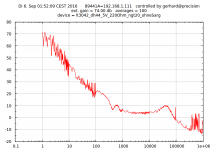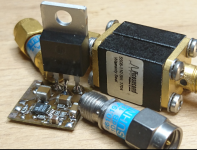One thing maybe to consider about using LDOs for analog loads could be whether it is a good idea to use an X7R or other class II output capacitor. IIRC somebody reported trying LT3042 with an SMD film output capacitor and found the behavior was very linear. However, good quality, minimal inductance 10uf SMD film caps may not be cheap.
One thing maybe to consider about using LDOs for analog loads could be whether it is a good idea to use an X7R or other class II output capacitor. IIRC somebody reported trying LT3042 with an SMD film output capacitor and found the behavior was very linear. However, good quality, minimal inductance 10uf SMD film caps may not be cheap.
The ref cap is important. A few 3042/5 pcb's come with ceramics on ref pin.
Not a good idea.
TCD
Hogwash.
There is no need to bolt the regulator to the engine of a helicopter.
This board was done from A-Z on a rainy Sunday. Circuit is directly
from the data sheet, measurement is limited by the preamp below 100 Hz.
Completely unshielded, open on the lab table, next to the computer screen,
under the switched LED microscope ring light and in the front of a 2*4
square meter array of 19" scopes, generators, spectrum analyzers etc,
each with a switching power supply of their own.
Fed by a R&S NGT20 via 1.5m banana cable.
X7R ceramic capacitors and still 2 nV/rtHz noise density, just as promised.
0 dB line is 1 nV/rt Hz, 6 dB more is 2 nV.
more on < spectrum_lt3042_DH44 | Noise spectrum of the LT3042+ D44VH10… | Flickr >
Gerhard
There is no need to bolt the regulator to the engine of a helicopter.
This board was done from A-Z on a rainy Sunday. Circuit is directly
from the data sheet, measurement is limited by the preamp below 100 Hz.
Completely unshielded, open on the lab table, next to the computer screen,
under the switched LED microscope ring light and in the front of a 2*4
square meter array of 19" scopes, generators, spectrum analyzers etc,
each with a switching power supply of their own.
Fed by a R&S NGT20 via 1.5m banana cable.
X7R ceramic capacitors and still 2 nV/rtHz noise density, just as promised.
0 dB line is 1 nV/rt Hz, 6 dB more is 2 nV.
more on < spectrum_lt3042_DH44 | Noise spectrum of the LT3042+ D44VH10… | Flickr >
Gerhard
Attachments
Last edited:
@Terry Demol: Just for clarification ... Are you talking about the output decoupling capacitor (>=4.7uF, less than 50 mohms & 2nH inductance according to data sheet) or are you thinking about the capacitor that may decouple the voltage setting resistor (e.g. up to 22uF). There isn't really any "ref" capacitor ;-)
Cheers,
Jesper
Cheers,
Jesper
Hmmm... I didn't read any posts claiming to change the noise performance of LT3045 with film caps.
My interest is piqued where the datasheet says: "Nonetheless, larger values of output capacitance do decrease peak output deviations during a load transient."
If so, then maybe better linearity during transients could be a good thing for some loads.
For whatever reasons, everyone who tried an LT304x board for ES9038Q2M AVCC thought it should be perfect based on specs. Then they found out a good op amp buffer for AVCC regulation (as ESS sometimes recommends) made for a better sounding dac.
That said, I use LT1763 for clocks, and with the right load caps and if the regulator is run at sufficient output current then the clocks exhibit the least audible jitter artifacts .
My interest is piqued where the datasheet says: "Nonetheless, larger values of output capacitance do decrease peak output deviations during a load transient."
If so, then maybe better linearity during transients could be a good thing for some loads.
For whatever reasons, everyone who tried an LT304x board for ES9038Q2M AVCC thought it should be perfect based on specs. Then they found out a good op amp buffer for AVCC regulation (as ESS sometimes recommends) made for a better sounding dac.
That said, I use LT1763 for clocks, and with the right load caps and if the regulator is run at sufficient output current then the clocks exhibit the least audible jitter artifacts .
Last edited:
Mark, are transients a consideration with WTMC?
There are not transients from oscillators and frequency doublers, they are virtually constant loads.
The only parameter to care is the noise, because a noisy regulator could affect the close in phase noise.
Hello,
The only parameter to care is the noise, because a noisy regulator could affect the close in phase noise.
I read this sentence before so now we should know it is true!
So in order to make these circuits work simply get yourself a circuit using lifepo4, supercaps or a combination of them. If current being drawn is very low you could complete disconnect the supply from the AC wall outlet if not find something that will not introduce noise.
Andrea tells us to separate clocks from the rest of the digital pile of circuits.
Andrea also tells us to use optical cables.
When using a ready built Roon Nucleus and a DDDAC i know there will be one circuit board connected to the I2S input on Doedes mainboard. This circuit should of course also have its power supply close by.
Which parts apart from clocks and power supply could be installed at a few meter distance from the DDDAC chassis without any degrading?
Greetings, Eduard
The only parameter to care is the noise, because a noisy regulator could affect the close in phase noise.
I read this sentence before so now we should know it is true!
So in order to make these circuits work simply get yourself a circuit using lifepo4, supercaps or a combination of them. If current being drawn is very low you could complete disconnect the supply from the AC wall outlet if not find something that will not introduce noise.
Andrea tells us to separate clocks from the rest of the digital pile of circuits.
Andrea also tells us to use optical cables.
When using a ready built Roon Nucleus and a DDDAC i know there will be one circuit board connected to the I2S input on Doedes mainboard. This circuit should of course also have its power supply close by.
Which parts apart from clocks and power supply could be installed at a few meter distance from the DDDAC chassis without any degrading?
Greetings, Eduard
How about the squaring circuits?
The transients of the sine to square converter are managed by the bypass capacitor installed close to the 74AC04.
The squarer is more sensitive to the noise coming from the regulator, high power supply noise affects the noise floor of the circuit.
The best phase noise performance we have measured was achieved using battery.
Using a standard 317 the noise floor increases.
BTW, I believe LT3042 or LT3045 based regulators are more than enough to get the best phase noise performance from oscillators, doublers and sine to square converters.
Hello,
The only parameter to care is the noise, because a noisy regulator could affect the close in phase noise.
I read this sentence before so now we should know it is true!
So in order to make these circuits work simply get yourself a circuit using lifepo4, supercaps or a combination of them. If current being drawn is very low you could complete disconnect the supply from the AC wall outlet if not find something that will not introduce noise.
Andrea tells us to separate clocks from the rest of the digital pile of circuits.
Andrea also tells us to use optical cables.
When using a ready built Roon Nucleus and a DDDAC i know there will be one circuit board connected to the I2S input on Doedes mainboard. This circuit should of course also have its power supply close by.
Which parts apart from clocks and power supply could be installed at a few meter distance from the DDDAC chassis without any degrading?
Greetings, Eduard
There are no optical cables with the FIFO Lite and the DAC Lite, fiber optic cables will be used in the top version of the FIFO/DAC only.
The only devices we suggest to install externally in the Lite version are the oscillators and the frequency doublers.
The top version is another thing since we will use 4-5 chassis and fiber optic cables for the FIFO/DAC.
I will start a dedicated thread about the top version as soon as it's ready (expect a couple of years).
Hello,
A couple of years? You mean when corona is gone?
Taking the recently posted picture made by you FIFO lite to DDDAC1794 as a guidance
So right now just the two Drixo boards with a 24/7 power supply close by should be in a separate enclosure at some distance ( meter?) from audio gear but the cables ( coaxial?) connect to the FIFO board can run along the ethernet cable going to the Roon Nucleus? Wouldnt be very smart to create physical distance and then having the garbage entered at the cables.
Greetings, eduard
A couple of years? You mean when corona is gone?
Taking the recently posted picture made by you FIFO lite to DDDAC1794 as a guidance
So right now just the two Drixo boards with a 24/7 power supply close by should be in a separate enclosure at some distance ( meter?) from audio gear but the cables ( coaxial?) connect to the FIFO board can run along the ethernet cable going to the Roon Nucleus? Wouldnt be very smart to create physical distance and then having the garbage entered at the cables.
Greetings, eduard
How about the squaring circuits?
Mark you have PM!! There is a problem with custom clearance for your package.
- Home
- Group Buys
- The Well Tempered Master Clock - Group buy

